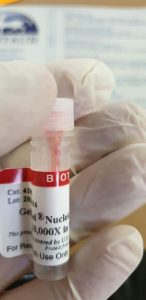Vitamin B12 has been broadly associated to methionine metabolism, which is an integral part for organic methylation reactions, together with DNA methylation. However, the connection between vitamin B12 and DNA methylation continues to be controversial. In addition, there’s rising proof for the affiliation between vitamin B12 and the danger of colorectal most cancers (CRC), though outcomes of this affiliation should be assessed with warning. For this objective, we hypothesized that serum vitamin B12 could possibly be related to international DNA methylation in the CRC context. To take a look at this speculation, we studied the affiliation between international DNA methylation by lengthy interspersed nuclear element-1 (LINE1) in CRC sufferers beneath the 25th percentile of serum vitamin B12.
We discovered that the excessive vitamin B12 group had low LINE1 methylation in each tumor space and peripheral blood mononuclear cells (PBMCs) than the low serum vitamin B12 group. LINE1 methylation ranges had been considerably decrease in tumor space in comparison with the adjoining tumor-free space, solely in the excessive vitamin B12 group. LINE1 methylation in visceral adipose tissue (VAT) and PBMCs had been correlated with tumoral, inflammatory, and insulin metabolism markers. However, the interplay between LINE1 methylation and vitamin B12 ranges was related to neoadjuvant remedy in the regression evaluation solely in males, suggesting a useful relationship. In conclusion, our outcomes reported an inverse affiliation between DNA methylation and vitamin B12 in the CRC context, which means that vitamin B12 could also be implicated in an epigenetic state or mediation in CRC.
Mutations in TERT promoter are established gatekeepers in early hepatocarcinogenesis, however little is thought about different molecular alterations driving this course of. Epigenetic deregulation is a crucial occasion in early malignancies. Thus, we aimed: 1) to research DNA methylation adjustments through the transition from preneoplastic lesions to early HCC (eHCC) and to determine candidate epigenetic gatekeepers, and 2) to evaluate the prognostic potential of methylation adjustments in cirrhotic tissue.
Roles of DEMETER in regulating DNA methylation in vegetative tissues and pathogen resistance
DNA methylation is an epigenetic mark vital for genome stability and gene expression. In Arabidopsis thaliana, the 5-methylcytosine DNA glycosylase/demethylase DEMETER (DME) controls energetic DNA demethylation through the reproductive stage; nevertheless, the lethality of loss-of-function dme mutations has made it troublesome to evaluate DME perform in vegetative tissues. Here, we edited DME utilizing CRISPR/Cas9 and created three weak dme mutants that produced just a few viable seeds. We additionally carried out central cell-specific complementation in a powerful dme mutant and mixed this line with mutations in the opposite three Arabidopsis demethylase genes to generate the dme ros1 dml2 dml3 (drdd) quadruple mutant. A DNA methylome evaluation confirmed that DME is required for DNA demethylation at a whole bunch of genomic areas in vegetative tissues.
A transcriptome evaluation of the drdd mutant revealed that DME and the opposite three demethylases are vital for plant responses to biotic and abiotic stresses in vegetative tissues. Despite the restricted function of DME in regulating DNA methylation in vegetative tissues, the dme mutants confirmed elevated susceptibility to bacterial and fungal pathogens. Our examine highlights the vital features of DME in vegetative tissues and supplies invaluable genetic instruments for future investigations of DNA demethylation in crops. This article is protected by copyright. All rights reserved.

The affect of the RASSF1C and PIWIL1 on DNA methylation: the identification of GMIP as a tumor suppressor

